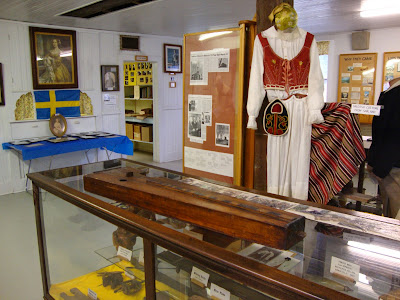Editorial note: In the list of captions to pictures below, there is a reference to a "melody string, center, attached to woods crew …" No, there were no tiny lumberjacks running around Jenny Lind Chapel, and they had no melody strings attached! That's what AutoCorrect did to me when I tried to write "wood screws" as one word.
Notes and pictures from my visit to the Jenny Lind Chapel yesterday with Ron Peterson of the Andover Historical Society, who removed the Esbjörn instrument from its display case and allowed me to measure it. (See also the picture with my post Psalmodikon -- misc. notes on resonance strings (resonanssträngar) immediately below on Sept. 5.) It is clearly a sophisticated, well crafted musical instrument.
Esbjörn was a protoge of Johann Dillner, who wrote the most important primer on the psalmodikon, and he was one of two founders of the Augustana Synod who used it widely in the early days. (The other was Eric Norelius, of Vasa, Minnesota.) His instrument is wider and deeper than Dillner recommended in his introduction to the 1846 sifferskrift (psalmodikon tablature) edition of Johan Olof Wallin's Swedish Psalmbook of 1819 (click here for details), but is approximately the same length. Its measurements:
- Length (along side of instrument): 44 inches.
- Breadth (at wide end): 11.75 inches.
- Breadth (at narrow end): 5.25 inches.
- Height: 3.75 inches.
- Fretboard: 29.75 inches.
- Vibrating string length (estimated): 33-34 inches.
The instrument was apparently designed for one melody string centered over the fretboard and 10 drone strings, five on each side of the fretboard. See Sept. 5 post below for details. Three strings are still attached. They appear to be loop-end metal strings (maybe 0.12 or 0.14 gauge?). And the end of what appears to be a gut string is attached to the bridge end of the psalmodikon.
Some other measurements: The fretboard is raised approximately 1 inch from the soundbox. Like other Swedish psalmodikons, it lacks metal frets but is cut in a shallow sawtoothed pattern The bridge is a block of wood 1 inch in height, 0.75 inch at the bottom and 0.25 inch at the top. It is cut in a right-angled trapezoidal pattern with the right angle nearest the fretboard.
The picture below, taken in 2013 when the instrument was in its display case, shows its overall proportions.
Other pictures below show: (1) At left, decorated sound hole, 8.75 inches from the nut end; (2) at right, nut end of psalmodikon with wooden peg for melody string. Drone strings are metal loop-end string slipped over woods crews; (3) metal tuning pegs on butt end of psalmodikon for drone strings and end of melody string, center, attached to woods crew; and (4) detail of nut end, showing tuner for melody string, at center, and resonant strings looped over wood screws at sides.





1 comment:
What is the gauge of the melody string? Thanks.
Post a Comment